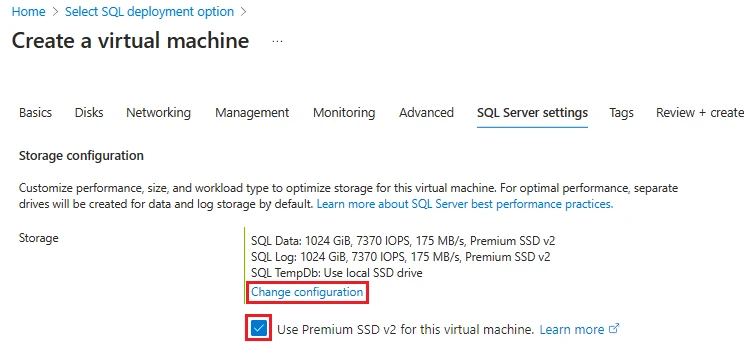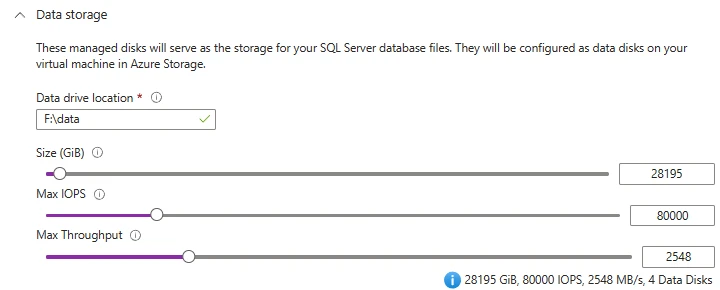Provision Premium SSD v2 Storage for Microsoft SQL Server on Azure Virtual Machines in the Microsoft Azure portal
Guidance on choosing SQL Server storage options in Azure
We’re excited to announce the public preview of the Premium SSD v2 provisioning experience for SQL Server on Azure Virtual Machines (VMs) deployed in the Azure portal. Premium SSD v2 storage improves performance, reliability, and scalability of your SQL Server workloads while offering robust resource capacity, as you can create a single disk with up to 64 TiBs, 80,000 input/output per second (IOPS), and 1,200 MB/s throughput.
When building Azure SQL VMs in the cloud, DBAs have several storage choices they can consider to give their applications the required performance and capacity their workloads require. In Azure, DBAs have compute options along with affordable storage designed to handle mission critical SQL Server workloads. In this article, we’ll review these options focusing on the latest capabilities of Premium SSD v2 storage and the Ebds_v5 Azure VMs, which are better together—providing the best combination of price performance capabilities in the cloud for SQL Server workloads.

Premium SSD v2 storage in Azure portal
Deploy SQL Server on Azure VMs with Premium SSD v2 disks using the Azure portal.
Managed disk storage options
DBAs looking to move their mission critical SQL Server applications from on-premises to the cloud have the managed disk options of Premium SSD (Gen 1), Premium SSD v2, and Ultra Disk for their production workloads where Standard SSDs are often used for dev/test and smaller departmental workloads. The goal of this article is to review the Azure VM storage options for SQL Server and give DBAs the tools and information needed to weigh the possible trade-offs in Azure feature availability and overall costs.
Premium SSD (Gen 1)
For most DBAs looking to build scalable storage with optimal price-performance, they use Premium SSD (Gen 1) managed disks for their storage solutions. Using first generation Premium SSD disks, DBAs can provision their VMs by striping disks of usually Premium SSD P30 or P40 disks in a storage pool. A storage pool allows DBAs to multiply disks up to the VM’s limits providing scalability and maximizing price-performance, while Premium SSD (Gen 1) disks allow DBAs to take advantage of Azure reservations and read-only host-caching.
While Premium SSD (Gen 1) storage exhibits remarkable flexibility and operates with minimal Azure feature limitations in the cloud, along with offering price-performance options through reservations for select disk types, it cannot scale to meet the demands of the latest Ebdsv5 VM series.
Additional differences between Premium SSD and Premium SSD v2 include:
- Premium SSD v2 offers higher disk capacity, up to 64 TiBs per disk, compared to 32 TiBs for Premium SSD.
- Premium SSD v2 provides more flexibility and control over disk performance, as you can independently adjust the disk size, IOPS, and throughput according to your workload needs, while Premium SSD (Gen 1) has fixed performance tiers based on disk size.
- Premium SSD v2 has lower latency and higher reliability than Premium SSD as it uses newer hardware and an improved storage platform.
- Premium SSD v2 supports higher levels of bursting compared to the previous generation, which allows you to achieve additional performance when needed for short periods of time without additional cost.
Ultra Disk
DBAs can also use Ultra Disk to meet the storage demands of the latest generation of Azure VMs as they offer sub-millisecond latency and better performance than Premium SSD (Gen 1). Like Premium SSD v2, Ultra Disk also allows DBAs to dynamically configure and scale the IOPS, throughput, and capacity of their disks independently without having to restart the VM or change the disk size. This makes Ultra Disk an attractive option for data-intensive workloads such as SQL Server that require consistency and high performance with low latency.
However, Ultra Disk also has drawbacks that make it less suitable for some scenarios. For example, Ultra Disk is only available in a limited number of regions and has stricter requirements for VM sizes, zones, and proximity placement groups. Ultra Disk also does not support disk snapshots, disk encryption, Microsoft Azure Site Recovery, or host caching options. Moreover, Ultra Disk is much more expensive than both Premium SSD and Premium SSD v2, especially for larger disk sizes.
Comparing VM and storage deployments
The established guidance for SQL Server VM deployments was to use Premium SSD (Gen 1) in a storage pool configuration with read-only caching for the data files. For the transaction log, we advised using Ultra Disk in cases where DBAs needed lower latency and could handle the limitations. This recommendation was especially the case for our previous hero VM series such as the Edsv4-series which offered the best performance for OLTP workloads at the time.
However, VMs continued to improve and with Azure Boost and other hardware enhancements, the newest Ebs_v5 and Ebds_v5 VMs have proven to be the optimal VM series for SQL Server workloads. The newest Ebs_v5 and Ebds_v5 VMs power higher levels of IOPS and throughput, and now with NVMe storage interface support they can scale well beyond the capabilities of Premium SSD (Gen 1). The Ebs_v5 and Ebds_v5 VMs series and larger VMs on the horizon will require a higher level of storage performance than Premium SSD (Gen 1) was able to provide. A higher level of storage performance is needed to match the capabilities of our newest generation of Azure SQL VMs and to avoid being throttled/capped when your application is pushing higher levels of IOPS/ throughput.
The next generation of Azure VMs will further push well beyond the largest storage needs of our current generation. For example, the largest machine in the previous generation Edsv4-series is the E80ids_v4 which is an Azure SQL VM of 80 vCores, 504 GiBs memory, 80,000 max uncached IOPS, and 1,500 MBps max uncached disk throughput. For a machine of this size, a Premium SSD storage pool would require 16 x P30 disks to provide the same number of IOPS that a single Premium SSD v2 disk could achieve, but with improved latency and less overall cost.
In comparison, the Ebds_v5 series has a VM size of E112ibds_v5 that supports 400,000 max uncached IOPS and 10,000 MBps max uncached disk throughput (Ultra/Pv2-SSD). Premium SSD (Gen 1) would require 80 disks in order to match the IOPs capabilities of this VM, which would exceed the max data disk limit of the VM.
Premium SSD v2 only needs five disks in a storage pool and additionally allows adjusting the IOPS and throughput based on needs for a better overall total cost of ownership (TCO).
Azure SQL VM best practices
Premium SSD v2 has more flexibility than Premium SSDs (Gen 1) and Ultra Disk. You can choose any supported size for a Premium SSD v2 and change the performance parameters without interruption. Premium SSD v2 does not have host caching, but it has much lower latency, which helps with some of the same issues that host caching helps with. The ability to modify IOPS, throughput, and size on demand means you can reduce the management workload of having to combine disks to meet your needs.
To get started, when provisioning a new SQL Server on Azure VM in the Azure portal, you can choose Premium SSD v2 for eligible VMs:

Premium SSD v2 allows you to change disk size, IOPS, and throughput independently to reach your performance targets, making workloads more cost efficient while also adapting to changing performance needs.
With a capacity of 64 TiBs, 80,000 IOPS, and 1,200 MBps of throughput, most environments can benefit from the performance capabilities of a single Premium SSD v2 disk—but for our largest Azure VMs, Premium SSD v2 disks can be combined into a storage pool to provide the performance required for a single logical drive.
When deploying your SQL Server VM image in the Azure portal, Premium SSD v2 is available for the Ebds_v5 and Ebs_v5 Azure VM series which are optimized for high-performance database workloads.

The following table helps visualize some of the performance gains and cost savings when using Premium SSD v2 with your Ebds_v5 and Ebs_v5 VMs:

1The HammerDB TPC-C workload is derived from the TPC-C Benchmark and is not comparable to published TPC-C Benchmark results, as the HammerDB TPC-C workload results do not fully comply with the TPC-C Benchmark.
Learn more about Premium SSD v2 storage for SQL Server on Azure VMs
In summary, Premium SSD v2 offers enhanced performance, granular scalability, and cost-effectiveness for applications demanding sub-millisecond disk response times. While it provides more capabilities, the actual cost difference between Premium SSD, Premium SSD v2, and Ultra Disks depends on factors such as region, disk size, IOPS, and throughput. You can use the Azure pricing calculator to estimate costs based on your specific needs.
If you are deploying SQL Server VMs using the Azure portal and want to utilize Premium SSD v2, note that it is currently limited to the Ebds_v5 or Ebs_v5 series VMs in this public preview phase.
We’re committed to providing our customers with the best possible experience when running SQL Server on Azure VMs. The addition of Premium SSD v2 storage is another step toward that goal.
Try out Premium SSD v2 storage for SQL Server on Azure VMs today and please share your feedback with us. We look forward to hearing from you as we continue to improve our offerings for SQL Server on Azure VMs.
To get started, check out Use Premium SSDv2 storage with your SQL Server on Azure VMs.
You can also keep an eye on the What’s new page for all the latest and greatest updates to SQL Server on Azure VMs and What’s new for Azure storage.
